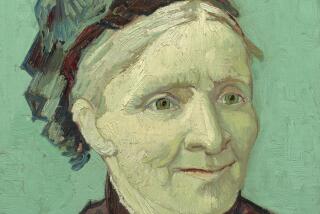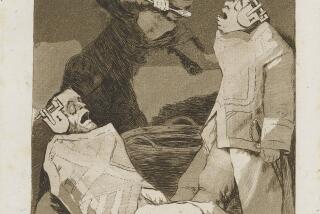‘Grand Illusion’ Is Grandly Restored
- Share via
Seeing Jean Renoir’s “Grand Illusion” in the miraculous print that is the raison d’etre for the new release that starts Friday at the Royal in West Los Angeles reminds us not just what a great film is but, even rarer, what a great film can look like.
Originally released in 1937, the status of this poignant World War I drama as one of the classics of French and world cinema has never been in doubt. It was the first foreign-language film to be nominated for a best picture Oscar (albeit in the era when 10 films made the cut), has appeared high up on numerous all-time-best lists, and caused Orson Welles to, yes, grandly proclaim: “If I had only one film in the world to save, it would be ‘Grand Illusion.’ ”
Despite all this deserved respect, most people who have enjoyed this film, including critics, have invariably admired it on the kind of scratchy, fuzzy prints made from overused nth-generation negatives that are the rule for movies of its time and place.
When Renoir personally oversaw an earlier re-release of “Grand Illusion” in 1958, the prints came from secondary materials because everyone involved, including the director, assumed that the original camera negative for the film had been destroyed in a 1942 Allied air raid that took out a Paris-area lab. But everyone was wrong.
For what makes the current prints of “Grand Illusion” so remarkable is that they come from that given-up-for-lost master negative. The result is an image so crystalline, so vivid in its shades of black and white, that it’s almost dizzying, a print so sharp that watching it feels like traveling back in time to the film’s initial release.
The story of where the camera negative was is a remarkable tale, one that begins, ironically enough, with Nazi propaganda minister Joseph Goebbels hating the film so much for its antiwar, pro-Jewish sentiments that he made it “cinema enemy No. 1” and promptly had the negative seized soon after the Germans occupied France in 1940.
That negative was sent on to Berlin’s Reichsfilmarchiv, which in turn fell victim to the fortunes of war when it was seized by the Soviet Army in 1945. The cans of film were sent to Moscow where they sat unnoticed until the mid-1960s, when the Soviet Gosfilmofond signed a film exchange program with France’s Cinematheque of Toulouse. With personnel and funding to closely examine holdings at a premium, the negative sat in Toulouse for nearly three decades more before the Cinematheque looked closely at what it had and collectively gasped in disbelief.
Titled “La Grande Illusion” in French (a name that, the exemplary Rialto Pictures press notes inform, would more accurately be translated as “The Great Illusion”), “Grand Illusion” is usually thought of as simply an antiwar film. In fact, critic Robin Wood has commented, its reputation as a “message” picture hurt it among postwar auteur critics who preferred Renoir’s more personal and idiosyncratic “Rules of the Game.”
But seen today, with its quiet performances by superb actors like Jean Gabin, Pierre Fresnay, Marcel Dalio and Erich Von Stroheim, “Grand Illusion” is most striking not for any pat sentiments but for the celebrated humanism that most characterized Renoir’s work. Simply but impeccably done, it emphasizes how much we can have in common in spite of the differences in class and nation that threaten to fatally divide us.
The film (co-written by Renoir and Charles Spaak) opens in 1916, with German air ace Capt. Von Rauffenstein (Von Stroheim) shooting down a French reconnaissance plane carrying the aristocratic Capt. de Boeldieu (Fresnay) and the working-class Lt. Marechal (Gabin, who wears Renoir’s vintage French Flying Corps uniform).
After a lunch to which Von Rauffenstein treats them after learning they are officers, the two Frenchmen are sent to a prison camp where they meet, among others, a wealthy Jewish officer named Rosenthal (Dalio), who makes life easier for everyone by sharing his elaborate food packages from home.
After numerous escape attempts in several camps, these three are reunited in the remote fortress-like prison at Wintersborn where Von Rauffenstein, removed from active duty after injuries caused by a crash that leave him in an elaborate neck brace, is in charge.
One of the themes of “Grand Illusion” is the end of the class-conscious comradeship across national lines, the “gentleman’s war” ideal that the German Von Rauffenstein, especially, embraces. Suspicious of the promotion of men like Marechal and Rosenthal to the officer class, Von Rauffenstein tells his French counterpart, sighing deeply, “We’re no longer needed.”
For his part, though understanding the German, De Boeldieu embraces the new egalitarianism, and the film goes even further, underlining the theme of shared humanity across class and national lines. When one character wonders at the lack of obvious demarcation as they approach the limits of German territory, a comrade replies simply, “You can’t see borders. They’re man-made.”
Yet many of “Grand Illusion’s” greatest moments have little to do with the war per se, like the electric scene in which a soldier dressed up for a prisoner-of-war drag show unexpectedly looks so much like a woman that for a moment no one is able to speak. With new subtitles (by Lenny Borger) that give us an improved sense of what’s being said complementing the new print, this is a film finally returned to its original state of grace.
More to Read
Only good movies
Get the Indie Focus newsletter, Mark Olsen's weekly guide to the world of cinema.
You may occasionally receive promotional content from the Los Angeles Times.










